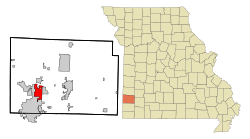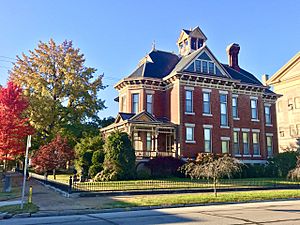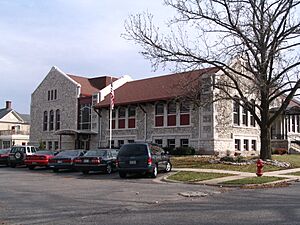Webb City, Missouri facts for kids
Quick facts for kids
Webb City, Missouri
|
|
|---|---|
| City of Webb City | |
| Nickname(s):
City of Flags
|
|

Location of Webb City, Missouri
|
|
| Country | United States |
| State | Missouri |
| County | Jasper |
| Area | |
| • Total | 8.64 sq mi (22.38 km2) |
| • Land | 8.64 sq mi (22.38 km2) |
| • Water | 0.00 sq mi (0.00 km2) |
| Elevation | 1,004 ft (306 m) |
| Population
(2020)
|
|
| • Total | 13,031 |
| • Density | 1,507.87/sq mi (582.22/km2) |
| Time zone | UTC-6 (Central (CST)) |
| • Summer (DST) | UTC-5 (CDT) |
| ZIP code |
64870
|
| Area code(s) | 417 |
| FIPS code | 29-78118 |
| GNIS feature ID | 2397239 |
Webb City is a cool city located in Jasper County, Missouri, USA. In 2020, about 13,031 people lived here. It's part of the bigger Joplin, Missouri area. Webb City has its own police, fire, and animal control services to keep everyone safe.

Contents
History of Webb City
How Webb City Started
Webb City was first planned by John C. Webb in September 1875. It became an official city in December 1876. At that time, about 700 people lived there. The city was built on part of John Webb's 200-acre farm. He bought this land in 1857.
Mining History of Webb City
In 1873, John Webb found lead while he was plowing his farm. With help from W.A. Daugherty, he dug the first mine shaft in 1874. Webb then let Daugherty and G.P. Ashcraft use his land for mining.
In 1876, the Center Creek Mining Company started working there. About 20 years later, there were 700 mines in Webb City and nearby Carterville. This area became the top producer of zinc ore.
Growth and Development
John Webb helped his city grow in many ways. He gave land for the first school and the first Methodist Episcopal Church, South. He also built the Webb City Bank and the first hotel.
Railroads came to Webb City, helping it grow even more. The St. Louis and San Francisco Railroad arrived in 1879. The Missouri Pacific Railroad followed in 1881. The city's population jumped from 1,588 in 1880 to 9,201 in 1900.
After a successful mine called "Yellow Dog" opened in the 1890s, business really took off. A large 100-room hotel, the Newland Hotel, was built. Webb City College, which allowed both boys and girls, was also started.
Webb City's mining area was shown at big events. It was at the Chicago Columbia Exposition in 1893. It also went to the 1898 Omaha International Exhibit. Webb City even won a silver medal for its mineral display.
A.H. Rogers built a streetcar line using mules from Webb City to Carterville in 1889. This led to the SouthWest Missouri Electric Railway, which started in 1893. It grew into a huge system called the Southwest Missouri Railroad Company. This system had a power plant, car barns, and a clubhouse for employees in Webb City.
Webb City During World War I
During World War I, the Webb City, Carterville, and Prosperity area produced a lot of zinc and lead. These minerals were worth over $18 million. Webb City's population grew to about 15,000 people during this time.
After the Mining Boom
After mining slowed down, Webb City started focusing on other industries and farming. In the 1930s and during World War II, plants near Webb City made explosives.
Several important buildings in Webb City are listed on the National Register of Historic Places listings in Jasper County, Missouri. These include the Downtown Webb City Historic District and the Middle West Hotel. The Elijah Thomas Webb Residence, a grand three-story home built by John Webb's son, is also on the list.
Geography of Webb City
Webb City covers about 8.63 square miles (22.38 square kilometers) of land. There is no water area within the city limits.
Mining District Legacy
In the late 1800s and early 1900s, Webb City was part of the "Tri-State Mining District." This was the world's largest and most productive area for lead and zinc mining. Even today, you can see piles of leftover mining rock, called chat piles, around the area. These chat piles are often used to build roads.
Population of Webb City
| Historical population | |||
|---|---|---|---|
| Census | Pop. | %± | |
| 1880 | 1,588 | — | |
| 1890 | 5,043 | 217.6% | |
| 1900 | 9,201 | 82.5% | |
| 1910 | 11,817 | 28.4% | |
| 1920 | 7,807 | −33.9% | |
| 1930 | 6,876 | −11.9% | |
| 1940 | 7,033 | 2.3% | |
| 1950 | 6,919 | −1.6% | |
| 1960 | 6,740 | −2.6% | |
| 1970 | 6,923 | 2.7% | |
| 1980 | 7,309 | 5.6% | |
| 1990 | 7,449 | 1.9% | |
| 2000 | 9,811 | 31.7% | |
| 2010 | 10,996 | 12.1% | |
| 2020 | 13,031 | 18.5% | |
| U.S. Decennial Census | |||
Webb City Population in 2020
The 2020 United States census counted 13,031 people living in Webb City. There were 4,672 households and 3,126 families. The population density was about 1,508 people per square mile.
- Most residents (82.46%) were white.
- About 1.65% were black or African-American.
- About 1.5% were Native American.
- About 1.24% were Asian.
- About 3.15% were from other races.
- About 9.75% were from two or more races.
- About 3.3% of the population was Hispanic or Latino.
About 33.7% of households had children under 18. The average household had 2.5 people. The average family had 3.0 people.
- 24.7% of the population was under 18 years old.
- 12.0% of the population was 65 years or older.
- The average age in the city was 33.5 years.
Webb City Population in 2010
As of the census in 2010, there were 10,996 people living in Webb City. There were 4,230 households and 2,840 families. The population density was about 1,274 people per square mile.
- Most residents (90.7%) were White.
- About 1.6% were African American.
- About 1.5% were Native American.
- About 0.9% were Asian.
- About 2.2% were from other races.
- About 3.0% were from two or more races.
- About 4.9% of the population was Hispanic or Latino.
About 38.4% of households had children under 18. The average household had 2.57 people. The average family had 3.10 people.
- 28.2% of residents were under 18 years old.
- 11.6% of residents were 65 years or older.
- The average age in the city was 32.1 years.
Education in Webb City
Most public schools in Webb City are managed by the Webb City R-VII School District. A small part of Webb City is in the Joplin School District.
Webb City High School is the main high school for the Webb City district.
For the parts of Webb City in the Joplin School District:
- Students north of East Zora Street go to Royal Heights Elementary School.
- Students south of East Zora Street go to McKinley Elementary School.
- All these students then go to East Middle School.
- Finally, all students in this area go to Joplin High School.
Webb City also has a public library, called the Webb City Public Library, where you can borrow books.
Notable People from Webb City
Many interesting people have connections to Webb City:
- W. Alton Jones: A famous businessman and helper of good causes. He was the President of CITGO from 1940 to 1953.
- Gordon Arthur Riley: A scientist who studied the ocean and its living things.
- John Roderique: The football coach for Webb City High School from 1997 to 2022. He won the most state titles in Missouri history.
- Grant Wistrom: A professional football player. He played as a defensive end for the St. Louis Rams (1998–2003) and the Seattle Seahawks (2004–2006).
- Grace Steele Woodward: A writer and historian.
|
See also
 In Spanish: Webb City (Misuri) para niños
In Spanish: Webb City (Misuri) para niños


